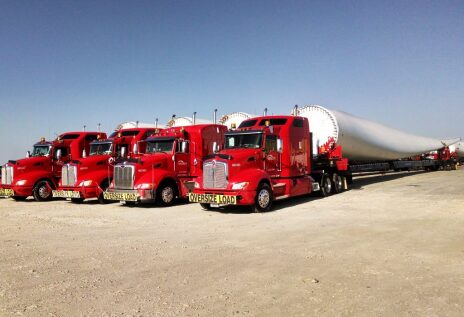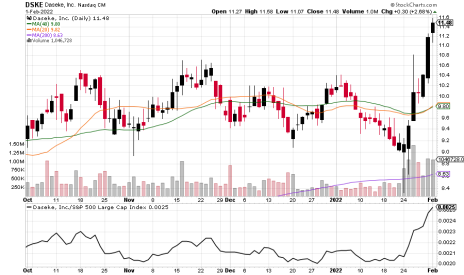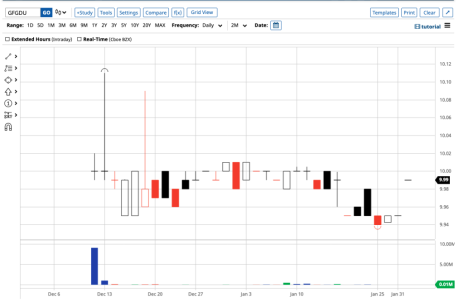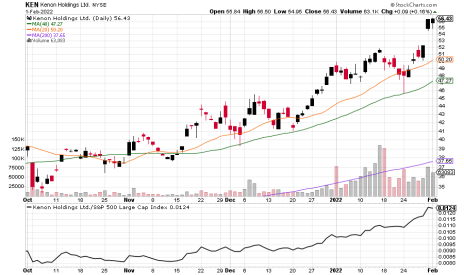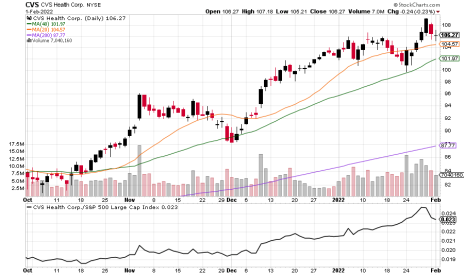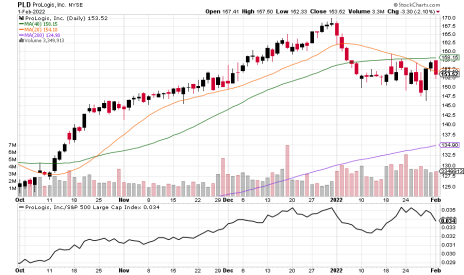It’s a bear market but there are still good stocks. This issue we add two to our Real Money Portfolio. One is a little-known company that with a niche in transporting renewable energy parts, like turbine blades. Its stock, technically, looks great and a management turnaround is taking hold. Our other pick is a Greentech special purpose acquisition company that will preserve our capital while giving us multiple options down the line to score big profits.
Also inside: our ESG Three, Greentech Timer and a full update on our Real Money and Excelsior portfolios.
Daseke (DSKE)
Overview
It’s one thing to design a wind turbine, site a bridge or plan a large renewable energy storage system. Building it is another. Very often, crucial components have to get from a manufacturing facility to their end destination. That means hiring a truck. Moving something like a wind turbine blade is a skilled job – the average blade in service is 160 feet or so – with new blades even longer. They don’t come in sections either because structural integrity is better when a blade is molded or welded whole. Here’s a brief video of one turning a corner (the link takes you to Facebook, to an official video posted by a Daseke subsidiary). You can also get a sense of the size of these cargos from this photo, taken in 2014.
The annual market for specialty and flatbed trucking is roughly around $150 billion in North America. Unlike other trucking segments, such as less-than-truckload (LTL) and intermodal, specialized transport is much more highly fragmented.
Business Model
Daseke (DSKE) is the largest trucking firm you’ve never heard of. It’s a roll-up of many smaller trucking companies cobbled together by an auditor-turned-entrepreneur named Don Daseke. He bought his first trucking firm in 2008 and spent the next decade buying more and more. His plan was to create a national specialty trucking business. That worked, in part: Daseke operates coast to coast and north to south in North America, with 10 operating companies, 11,000 specialized trailers and some 4,500 tractors to use them, making it the largest specialty trucker in the U.S. and the 15th largest truckload carrier overall.
We’ve long watched Daseke for its unique niche in the transport of renewable energy equipment, but from a financial point of view, cobbling the business together was inefficient. Daseke went public in 2015 by SPAC and Don Daseke retired from the company in 2019. That year a new management team came in from outside and set about looking to maintain Daseke’s leading position in specialty transport while moving to improve operational and financial efficiency. Based on its earnings results announced last week, we think management has finally started to see momentum from its efforts.
Daseke reported full-year 2021 results of $1.6 billion in revenue, up 11% from the prior year, and reflecting stronger construction business with a downtick from a very strong wind turbine transport year in 2020. The business turned a GAAP net profit of $56 million (about 90 cents a share) and showed improvement in every other financial metric, including rate per mile up 13% to $3.34 (by comparison, LTL trucker Knight-Swift (KNX) generated $2.83 a mile last quarter). Renewable energy comprises 15% of sales. The firm also moves everything from Navy submarines to Boeing planes to general cargo, with construction being its largest segment at 27% of revenue. Metals are 15%, aerospace is 12%, manufacturing 11% and general cargo 20%, accounting for the rest of business.
Business Outlook
For this year, management is projecting revenue will increase 4% to 7% and EBITDA will grow faster, at 5% to 10%, signaling continued execution on management’s revamp. Essentially, the efforts are around streamlining what is very much still a collection of independent businesses, rather than one operation fronted by a series of brands. Some of that effort is around data and analytics, which will allow the company to introduce more dynamic pricing and be able to gauge the market regionally and nationally. Other is more traditional business consolidation – seeing where subsidiary operations can be combined. Daseke’s leadership appears more thoughtful around consolidation, however, seeming apt to give weight to the status quo when on-the-ground conversation with drivers and clients indicate strong loyalty to brand – evocative of why Ford (F) maintained its Mercury brand for many years after the business had simply become nameplates stamped on the exact same cars. More than 90% of Daseke’s business is booked directly with clients, not brokers, so client preferences mean a lot.
More importantly, there are dynamics we expect will continue to benefit Daseke. One is the infrastructure bill from November. Let’s not forget it’s a trillion-dollar effort that will quite literally be funding new bridges, renewable energy fields and electrical grid improvement that will directly spark more demand for Daseke’s specialized equipment and staff. Management’s projections don’t make any allowance for it (in part because of uncertainty of how and when the money gets appropriated). Another factor is that the supply chain troubles on getting new tractors and trailers mean the trucking industry isn’t adding new rigs at the pace they normally would in boom times. That’s going to keep prices high. Oil prices may have some effect on demand if they continue to climb, but Daseke operates less on spot contracts than other truckers, plus industry-wide surcharges for fuel have become an accepted norm. A third factor is driver turnover well below industry rates, caused in part by the fact flatbed drivers make more money generally and that Daseke prioritizes making sure they pay a premium over competitors for drivers. Lastly, the company has an effective network of contract drivers and affiliates to offer additional capacity.
We also like that management has shifted to more asset-light operations, having reduced rig count about 18% the past two years, replacing them with driver-owned rigs; slashed debt-to-equity from 3.5 to less than 1 in the same time. Despite the advances, the company still trades at about a 30% discount to trucking peers in stock market valuation. That offers low-hanging fruit to gather to the upside as its story gets out. In short, we see Daseke as a business that will benefit from green infrastructure and one of the few ways into Greentech in the transports sector.
Issues to Consider:
- DSKE’s discount to peers may not narrow since it has been largely consistent in recent years.
- Its excellent technical performance makes the stock stand out in the current market. However, at $660 million market cap, it is a small cap with all the risk that come with that.
- Inflation, fuel costs and a tight employment market could affect results.
- There are warrants remaining from Daseke’s going public in 2015. Those expire in March and could result in a greater share count or possibly an accounting restatement, since the warrants aren’t a liability. 2021 SEC guidance generally led to widespread re-accounting of SPAC warrants as a liability (though whether they are or not are specific to the warrant’s foundational language).
- Transports have lately turned bearish. The Dow Jones Transports average did push back over its 200-day average Tuesday, however.
Technical Analysis
DSKE is showing excellent Relative Strength compared to the S&P 500. Right now, it has the best combination of RS and chart of the Greentech universe, with shares over their 40-day and 200-day moving averages and at a four-year high. Shares have been building a base between 8.30 and 10.30 since September, placing shares poised to work higher. Buying volume since earnings has been strong and price internals suggest momentum will continue. Funds have been coming into shares in recent months. Support is at 9.70, 8.60 and between 8 and 7.15. The all-time highs around 14 is natural resistance. We pegged 10.50-11 as a more important level in preparing this report and this week shares have pushed through that level. Even with the advance over 11 this week, shares remain attractive technically and fundamentally.
What to Do Now
It’s a bear market but DSKE shows multiple signs of a being a healthy stock. Valuation – a price-to-earnings of 12, compared to 21 for trucking and 28 for transports – tells us we have less downside risk here than other RS and momentum-based picks in these market conditions. BUY
Daseke Inc (DSKE)
Revenue (trailing twelve months): $1.6 billion
GAAP Earnings per share (trailing twelve months): $0.90
All-time high (intraday): 14.52
Market cap: $645 million
Recommendation: Buy
Intended Portfolio: Real Money
Growth for Good (GFGDU)
Overview
The peak of the SPAC bubble eleven months ago obscured a few of the unique attributes that helped bring them to prominence: mainly, that special purpose acquisition companies provide individual investors like us a free or very low-cost option at private-equity-like deals. If we like them, we can stay invested; if we don’t, we can get our money back. Or – and this is the really exciting part: we can do both.
What are SPACs? They are companies that raise money in an IPO with the goal of then finding another company to merge with – usually private businesses that want to go public. Usually, but not always, they declare what sectors or geographic areas they are looking to enter, but they can do any deal they can get shareholder approval for. Most SPACs hold an IPO by selling units at $10, consisting of one share and usually something else, like a portion of a warrant (the right to buy another share at $11.50 post-merger) and sometimes a right – the grant of another share after a merger.
In exchange for this flexibility SPACs have to do a few things: one is the IPO money has to be put into trust, which shareholders can demand back at the time of a vote for a business combination. SPACs also have to declare a timeframe for their existing: a period they have to effect a merger or shut down and return that per-share trust money back. That runs anywhere from one year to three. SPACs also have variables around management automatically extending those search periods, when they can redeem warrants and a number of other things all of which means one shouldn’t just buy SPACs pell-mell. But some awareness and a willingness to take periodic steps to preserve your investment opens up a large world of unique opportunities to put money to work. SPACs aren’t coming public at the furious pace of January and February 2021, where literally hundreds of SPACs filed and held IPOs. But they continue to come to market and have a core institutional investor base that invests in various stages.
Business Model
We’re recommending the units of a Greentech and ESG-focused SPAC called Growth for Good (unit ticker is GFGDU). This is driven by almost entirely by two factors: that its unit offering and structure maximizes our profit potential compared to other recent SPACs and that it fits into our Greentech investing focus. We’ll cover Growth for Good’s investment opportunity for us below.
Secondary considerations include the quality of the management team.
The SPAC raised $220 million in December. Its primary focus is on finding a clean tech business, in the areas of food and agriculture, energy, the “built environment,” transportation, consumer goods and heavy industry. Its units consist of: one share, half of a warrant to buy another share and one-sixteenth of a right, which is the right to another full share after the SPAC closes a merger. The trust holds $10 a share. The effort has 18 months to find a business combination. Extendable once to 21 months with the deposit of any addition 10 cents a share into the trust.
Generally speaking, we look for teams to fall into one of three buckets: superior, suitable and inferior. This is a judgmental effort in which we’re looking for teams that can generate deal flow and lessen the risk to us of having our money parked in SPAC shares. The downside is we buy into a SPAC where shares end up trading at enough of a discount that we’re stuck waiting for SPAC shut down or a vote on a merger to get our investment back. Most management teams we judge as suitable, which is where Growth for Good falls.
There are three co-founders – the ones who put up the risk capital to launch the SPAC. One is Yana Watson Kakar, a long-time sustainability consultant at Dahlberg Global Consulting, a Swiss corporate advisory. She was a global managing editor there before starting the SPAC. A lecturer on sustainable investing at Harvard and a long-time Wall Street banker, Vikram Gandhi is SPAC chairman, and Celeste Clark, a long-time member of many corporate boards, are the other two co-founders. We’d prefer more direct business or investing experience among them, but the nine other directors and advisors bring enough business heft, including time at Credit Suisse’s sustainability practice, Twitter, and private equity.
Our Investment Plan
Growth for Good units traded solely as units from December 13 to Monday this week. The units can now be split by shareholders, but they don’t have to be. Units continue to trade now and we want to buy the units, not the components that have be separated. GFGDU has been trading at a slight discount to the trust value – typical of SPACs recently, so our aim is to buy units at or below the trust value.
After purchase and settlement, request your broker (you have to ask them) to split the units into its components. That typically takes brokers a few days to effect the split, after which we will have shares – which have claim to that $10 per share trust, as well as warrants and rights.
Shares will trade around $10 from then on until there is news. We will look to sell our shares in one of two situations: when share prices spike on well-received news of a merger agreement or, if shares stay at or below trust value, we collect the trust funds. That can happen at the merger vote, where we declare we want the funds back, or when the SPAC holds a shareholder vote to extend the SPAC beyond the time frame stated in the prospectus, or when the SPAC closes and returns trust funds by rule. In the case of GFGD, that would be about $10.11, the IPO trust value and the additional dime from management electing to extend its window from 18 to 21 months plus a penny in interest from the trust’s investment in U.S. Treasury notes. Provided we buy at or below trust value, that means we won’t lose money and make a savings-deposit like 1.1% return, annualized rate of 0.63 percentage point.
That protects our downside. Our upside is from the warrants and rights. Warrants don’t become exercisable until a month after a merger is completed, but as we know from our Excelsior Portfolio, they trade freely and are the more active and volatile vis-à-vis SPAC shares.
Warrants are trading in the 30-cents region after the split, but should advance closer to $1, a more normal price for a searching SPAC. Warrants will spike dramatically on deal hopes, as warrants are the primary way traders play SPAC deal news. With GFGD warrants, their maximal value is $6.50 each. That’s the difference between the exercise price of $11.50 per warrant and the company’s right to redeem warrants when post-merger shares have traded at $18 or more for 20 of any 30 days. If our warrants hit $6.50 or more we have the option to sell and book a 32.3% gain on our unit purchase, assuming we sold the shares at trust value. If we’re especially bullish on the company being brought public we keep the warrants, since it is possible for warrants to trade above $6.50, if traders feel share prices will advance more dramatically ahead of a redemption call.
Lastly, we have the rights. To my mind, these are the most valuable parts of a SPAC offering – you don’t see them often and so it is difficult to say with any certainty the trading and price patterns around them. What makes the rights so valuable is we receive them whether or not we’ve sold the original share in the unit and then never expire and can be forcibly redeemed – because they’re common equity as soon as a merger closes. Assuming our merger SPAC trades at $10 after the merger (not uncommon), the rights for GDGD themselves provide a return of 7%. In this specific situation 16 rights equal one share. GFGD’s rights are trading at 17 cents after the split.
Taken altogether this SPAC offers us:
- Near-certain return of our initial capital (Acts of God-like systemic events really are the risk)
- A bank-like return on parking our capital. The option to sell shares in the open market to recover all or most our original investment beforehand, if we need the money.
- The upside-only warrants and rights that will be our real profit.
- Assuming warrants trade around $1 – neither good nor bad – and the merger trades at $10 after closing (probable early on) and we sell at those prices, we’ll book an 11.25% return on our original money.
- A reasonable scenario of a merged business trading at $18 a share within five years of the merger, which would bring a 44% return on the trade (the rights at $18, the warrants at their “proper” price of $6.50)
- Very long-term upside in the form of the shares acquired through rights.
Issues to Consider:
- Warrants and Rights are worthless if there never is a merger and the SPAC returns the trust capital to us in 18 or 21 months.
- Warrants expire worthless five years after the merger closes.
- Warrants called for redemption must be sold or exercised for shares within 30 days of the call (potentially posting $11.50 cash for every warrant under SPAC rules). If we do nothing, they will expire at 10 cents apiece.
- SPAC shares can trade at premiums, as they did in 2019-2020, but they can trade at a sometimes-sizeable discount. That means to recover our original capital, one may need to wait out a SPAC merger vote or SPAC unwinding – 18 or 21 months in this case.
- Rights are only as good as the shares. SPACs that close mergers hated by the markets will have shares trading well below $10.
- The market may be illiquid for warrants and rights and even SPAC shares if sentiment turns sharply against them. SPACs are new but being widely traded in the market.
Technical Analysis
GFGDU went public at 10 a share and has seen a peak of 10.10 and a low of 9.94. In current market conditions, compared to other SPACs, this is normal. There is little technical indication to be taken from the charts other than the fact daily trading volume can be light – usually in the tens of thousands of units a day of late, but it has also seen days in the hundreds of units – so large orders may affect the market. Don’t chase prices here.
What to Do Now
Buy Growth for Good units, only – mind the ticker, which is GFGDU for units (GFGD will be shares and GFGDW are the warrants, GFGDR are the rights). Look to buy at or below the trust price of 10. Liquidity is already much less than it had been weeks ago. Split your order in to round lots of 100 or so. Do buy an amount evenly divided by 16 – partial rights aren’t awarded. Don’t chase prices here over trust value of 10. We may need to accept there isn’t enough liquidity to get into units at the size we’d prefer. Eventually, unit volume will crawl to nothing. BUY at $10 or lower.
Growth for Good Acquisition Co. (GFGDU)
IPO Amount: $266 million
IPO Trust Capital per share: $10.00
All-time high (intraday): 12
Market cap: $188 million
Recommendation: BUY
Intended Portfolio: Real Money
The ESG Three
The ESG Three are three technically strong stocks selected from the 200 most-held stocks in environmental, social and governance focused mutual funds and ETFs. ESG fund holdings tend to be weighted toward blue-chip companies drawn from every industry which are rated highly in social and governance aspects. We screen top performers further to eliminate widely held companies we believe have clear environmental, social and/or governance problems. These aren’t formal stock picks but suggestions for those looking to explore additional stocks beyond the Greentech portfolio.
Kenon Holdings (KEN)
What is it?
A small Israeli conglomerate with interests in electrical generation, a China car- and electric scooter-maker and marine shipping.
Why is it ESG?
It is considered ESG by the Vanguard ESG International ETF. Vanguard does its own ESG due diligence which we consider effective. Kenon is too small to be scored by other ESG services.
Why now?
KEN is one of the strongest stocks by Relative Strength in the market. Shares reached an all-time high of 55 this week.
CVS Inc (CVS)
What is it?
A pharmacy and retail chain.
Why is it ESG?
On par with peers on social and governance aspects, it is considered superior on environmental concerns. ESG funds own $311 million of shares.
Why now?
Shares broke through long-term resistance in December and recently hit an all-time high of 109.27 as they look poised to advance off a base.
Prologis Inc (PLD)
What is it?
A real estate investment trust focused on logistics-related properties.
Why is it ESG?
By sheer property size it has the largest green-certified building holdings in the U.S. and has committed to notable reductions in emissions by 2025. ESG funds own $370 million of shares.
Why now?
Strong 2022 guidance earlier this month sparked a series of brokerage analyst upgrades. Shares face immediate resistance at 158, but remain in a firm uptrend.
Greentech Timer & Current Portfolio
The S&P 500 had its worst January since 2009 (down 5.3%), while the Nasdaq lost 9%, its worst first month since 2008. Not surprisingly, Greentech also endured its worst January since 2009, with the benchmark Wilderhill Clean Energy Index dropping 20.9%. We’re at 16-month lows in Greentech here, with the index below its moving averages, all of which are trending downward. It’s bearish. Solar, wind, water and other subsectors with just a few stocks (fuel cells, nuclear) are all also bearish.
Entering the year, Greentech stocks (as represented by the Wilderhill Index) were trading at a 28 price-to-forward-earnings ratio, compared to 29 for the Nasdaq 100. But there’s a case to be made that Greentech’s selloff has been overdone because it was already much cheaper by other metrics: its price-to-book started the year at 1.9, while the Nasdaq 100 entered the year at 7.3. Greentech’s price-to-sales, the most basic metric we look at, was 1.6, compared to 4.9 for the Nasdaq 100. Some of this could be attributed to the fact that Greentech isn’t pure tech – there are industrials and consumer staples and discretionary in our universe. But it still looks in better shape. That doesn’t mean we should be jumping in heavily now – it’s better to wait for the market to turn and be a little late than too early.
For now, we’ll grit our teeth and wait out the drawdowns in some of our holdings especially the Excelsior Portfolio, and be cautious in our Real Money Portfolio.
Our Greentech Timer is bullish when the index is above the 20-day and 40-day moving average and those averages are upward trending (ideally, the index is also above an upward trending 200-day moving average too, but not essential). Right, now our Timer is bearish. It’s important to maintain sell-stops and enter trades cautiously.
Current Portfolio
Real Money Portfolio
| Stock | Ticker | Buy Date | Buy Price | Price on 2/2/22 | Gain/Loss | Rating | Sell-Stop |
| Advanced Water Systems | WMS | 1/6/22 | 130.85 | 115.04 | -12.08% | Hold | None |
| Aptiv | APTV | 11/18/21 | 177.01 | 140.05 | -16% | Sold at 148.55 | |
| Archaea Energy | LFG | 12/2/21 | 18.27 | 17.88 | -2.13% | Hold | Under 14 |
| Charah Solutions | CHRA | 2/2/22 | — | 5.43 | — | Buy | None |
| Heritage Crystal-Clean Inc. | HCCI | — | — | 28.90 | — | Watch | |
| KraneShares China Green Energy | KGRN | — | — | 41.21 | — | Watch | |
| Lithium Americas | LAC | 1/20/22 | 27.60 | 27.05 | -1.99% | Buy | Under 19 |
| Onsemi | ON | 8/4/21 | 44.63 | 60.49 | 35.54% | Sold 2nd half at 56.73 |
Excelsior Portfolio
| Security | Ticker | Buy Date | Buy Price | Price on 2/2/22 | Gain/Loss | Rating | Note |
| ADS-Tec Energy Warrant | ADSEW | 10/20/21 | 1.66 | 1.07 | -36% | Hold | |
| FuelCell Energy | FCEL | 1/6/22 | 5.20 | 4.38 | -15.77% | Hold a half | |
| Navitas Semiconductor Warrant | NVTS.WS | 6/16/21 | 2.57 | 2.70 | 5% | Hold | |
| Origin Materials Warrant | ORGNW | 6/16/21 | 2.43 | 1.07 | -56% | Hold | |
| Ree Warrant | REEAW | 6/16/21 | 1.10 | 0.89 | -19% | Hold | |
| ReNew Power Warrant | RNWWW | 6/16/21 | 1.81 | 1.29 | -29% | Hold | |
| Volta warrant | VLTA.WS | 6/16/21 | 2.21 | 1.23 | -44% | Hold |
Sold positions
| Stock/Security | Ticker | Buy Date | Buy Price | Sell Price | Gain/Loss | Sell Date |
| Aemetis, Inc. | AMTX | 9/24/21 | 14.63 | 14.76 | 1% | 12/14/21 |
| Aptiv | APTV | 11/18/21 | 177.01 | 148.55 | -16.08% | 1/19/22 |
| Array Technologies | ARRY | 11/18/21 | 25.30 | 17.95 | -29% | 12/1/21 |
| Aspen Aerogels | ASPN | 10/6/21 | 45.99 | 50.12 | 9% | 12/21/21 |
| Centrus Energy | LEU | 9/21/21 | 33.46 | 69.66 | 108% | 11/17/21 |
| Centrus Energy | LEU | 9/21/21 | 33.46 | 49.68 | 48.5% | 12/6/21 |
| Enphase Energy | ENPH | 11/10/21 | 228.73 | 188.94 | -17% | 12/22/21 |
| ESS Tech | GWH | 11/18/21 | 14.97 | 10.33 | -31% | 1/6/22 |
| Li-Cycle Warrant | LICY.WS | 6/16/21 | 2.42 | 2.52 | 4% | 12/27/21 |
| Navitas Semiconductor Warrant | NVTS.WS | 6/16/21 | 2.57 | 6.68 | 160% | 11/18/21 |
| Onsemi | ON | 8/4/21 | 44.63 | 57.60 | 29.06% | 1/20/22 |
| Onsemi | ON | 8/4/21 | 44.63 | 56.68 | 27.00% | 1/26/22 |
| Wolfspeed | WOLF | 11/4/21 | 129.99 | 117.38 | -10% | 12/3/21 |
Real Money Portfolio
Our primary portfolio is the Greentech Real Money Portfolio – we invest alongside subscribers in the picks we make. That portfolio is designed to be fully invested at 12 stocks of equally sized initial investments. When the sector is bullish, we keep our cash in the ETF based on our benchmark index – the Wilderhill Clean Energy ETF (PBW). When bearish, we keep our cash in U.S. Treasury bills. We prefer to execute sell-stops on daily closes at or below our sell-stop mark, rather than intraday lows – but either way will work fine in the long term.
Advanced Drainage Systems (WMS)
The maker of pipes and septic equipment from recycled plastic has bounced nicely off the lows of last week, finding support suggested by charts around 104. Up about 8 points from that low, shares are still under resistance from 117 to 125. Earnings for its third quarter will be announced tomorrow before the market opens. Consensus has inched downward three cents to 91 cents earning per share, on sales of $647 million. We don’t have a firm sell-stop on right now. HOLD
Archaea Energy (LFG)
The landfill gas producer struck a purchase and sale deal with Fortis (FTS). Fortis’ British Columbia subsidiary will buy up to 7.6 million MMBtu of renewable natural gas (RNG) annually for 20 years. To put that into perspective, Archaea produced about 5.4 million MMbtu in 2021. Shares are challenging resistance around 17.50 this week and a move to over 18 would be nicely bullish. We’re keeping our rating at Hold with resistance at prices now, and with market conditions, but shares do have the technicals of starting an uptrend. HOLD
Chara Solutions (CHRA)
Chara has held support and is about to see a Golden Cross, when the 40-day moving average crosses over the 200-day. On balance, over more than 100 years of trading data and research, such a crossover is much more likely to be a winning trade than just buying at any point. Of course, there are plenty of exceptions to that broad rule. Chara is trading at a price-to-2022-sales of 0.5 and should start to see tailwinds from the EPA’s decision to enforce a law around the remediation of coal ash pools. We now recommend buying here. Volatility measures and the charts suggest 4.50 would be a support level should near-term support at 4.90-5.00 break. Resistance sits up at 6, near a multi-year high. BUY
Heritage-Crystal Clean (HCCI)
The waste remediator has technically broken a setup it was forming when we featured it. Share have also broken support at the 200-day average and seem certain to see a Death Cross, the move of a shorter moving average beneath the longer term one, soon. We can keep an eye on it for now, but we’re likely to drop it from our Watch List without improvement. WATCH
KraneShares China Green Energy (KGRN)
We’re still expecting a move towards a support line at 37 and want to see how shares react to the test. Generally, Chinese equities had a poor 2021, leading to a broad feeling the country’s shares will have a better 2022. Similar to Greentech vis-à-vis U.S. tech stocks, Chinese environmental issues are cheaper than China stocks generally, on a ratio basis. WATCH
Lithium Americas (LAC)
The lithium producer shares have been weaker, but really haven’t tested support and seem about to test some initial price resistance at current levels. The main risk is the end game of legal action to stop the company’s large Nevada mine, which seems unlikely, as well as protesters causing delays, which also seems unlikely (protest groups are fractured and arguing with each other over non-environmental issues). Chart-wise, support is at 22, resistance at 28-29. The long-term trend is up. BUY
Onsemi (ON)
We’ve took profits on Onsemi given market conditions and concerns the chipmaker may lack support given its historic tendency to trade at a discount to semiconductor making peers. We first sold half on Thursday, January 20, at 57.60, a gain of 29.1% on that portion. In last week’s weekly update we recommend selling the balance. The portfolio booked the sale at 56.73, the midpoint between the afternoon’s high and low, after subscribers had received the update. The profit on the second half is 27.1%. Combined, we made 28.1% on the trade, which we entered in August. Shares are a touch higher today and continue to look fine. SOLD
Excelsior Portfolio
Excelsior is our special opportunities portfolio, and is managed without consideration to the Real Money Portfolio. We may or may not recommend sell-stops in Excelsior.
In June we purchased five SPAC warrant positions as a basket trade: Navitas, Li-Cycle, ReNew, Ree and Volta. Of these, Li-Cycle, was closed at a 4% profit in December.
ADS-Tec Energy (ADSEW)
The German ultrafast EV charger maker has been weak, with our warrants holding around a dollar. The shares are around 9 and improving. CEO Thomas Speidel posted a note to shareholders yesterday expressing a belief Wall Street is receiving management presentations well and that he is getting more mainstream press requests. HOLD
FuelCell Energy (FCEL)
Little news from our fuel cell manufacturer. We hold a half-sized position with a long-term horizon. Shares are in the midst of both resistance and support, so some choppy action could be in store for now. HOLD
Navitas Semiconductor (NVTSW)
Warrants are basically unchanged from last week. Management has been presenting to Wall Street, making the case for its gallium nitride (GaN) based semiconductors as a way to lower the costs of solar inverters, EV electrical systems, data centers and consumer products, like laptop charging. The company will report earnings February 15. Consensus is 2021 will result in a loss per share of $1, meaning Q4 should be a 25-cents loss. Outlook will be far more importantly, given Navitas’ relatively low sales figure as GaN adoption ramps up. We sold three-quarters in mid-November at 6.68, booking 160% profit on that portion. Should warrants rally back to 6.50, we recommend selling. HOLD
Origin Materials (ORGNW)
Warrants are basically unchanged over the past week, having stabilized after a run of weakness. There’s no recent news. Shares remain in the low-5 area. These warrants are only redeemable by the company when shares are at 18 or higher for the bulk of a month. HOLD
Ree Automotive (REEAW)
Warrants are a little bit stronger this week on no news for the EV chassis maker. HOLD
ReNew Energy Global (RNWWW)
ReNew sold a portion of its India rooftop solar portfolio for $90 million, a gain on the project. The company says it’s part of its plan to invest in higher-return renewable energy projects. Warrants are also basically unchanged form a week ago, though have seen dips below 1 at times. HOLD
Volta Inc (VLTA.WS)
The company named a new executive position, appointing an auto industry veteran, Rick Baker, to lead “charging solutions” to coordinate between the display ad part of Volta’s business and the charger sales side. Warrants are largely unchanged over the week while shares are improving, recently at 5.18. HOLD
Thank you for being a subscriber. Our next SX Greentech Advisor issue is published Wednesday, February 16. Our regularly schedule update will be Wednesday, February 9, with alerts as needed. Please send along your comments and questions anytime to me at brendan@cabot.net.
The next Sector Xpress Greentech Advisor issue will be published on February 16, 2022.
